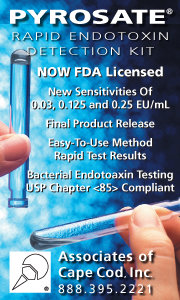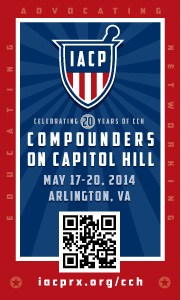|
|
|
 |
| |
 Letter from the Editor Letter from the Editor |
|
Editorial: USP Chapter <800> Applies to BOTH Dispensing and Compounding Pharmacies!
The proposed enforceable USP chapter <800> is out for comment, as we presented in this column a few weeks ago. It is critically important that ALL pharmacists and pharmacy technicians read this several times and respond to the USP as it is something that must be lived with when it becomes official. One aspect of national committee work I have experienced over the past 40+ years is that there are many unforeseen consequences of regulations and standards when something is put in place without the input of experienced diverse stakeholders on the front line. YOU are a stakeholder!
Section 1.3 Overview starts out with a very provocative statement; "There is no acceptable level of personnel exposure to HDs."
If that is the case, then regardless of what one does, they will always be "noncompliant" with <800> because it is impossible to operate a compounding OR a dispensing pharmacy without even a very low, miniscule level of HDs in the air. Does this mean that these pharmacies will be cited, fined, and/or eventually closed down?
However, in Section 17. Environmental Quality and Control, it states:
Common marker HDs that can be assayed include cyclophosphamide, ifosfamide, methotrexate, fluorouracil, and platinum containing drugs. If any measurable contamination (cyclophosphamide levels more than 1.00 ng/cm2 have been found to cause human uptake) is found by any of these quality assurance procedures, practitioners shall identify, document, and contain the cause of contamination.
The reference to a "threshold level" seems more appropriate as an initiator of corrective action rather than "�no acceptable level�." It seems it would be appropriate for a threshold level to be required for each HD so it can be properly enforced (however, not all have threshold levels and that makes this even more confusing or onerous.) Perhaps NIOSH and/or OSHA should develop these levels prior to each HD being required to be controlled for better informed practitioners.
This also seems incompatible with the statement following the provocative statement mentioned at the beginning which says "The processes listed in this chapter are intended to provide containment of HDs to as low a limit as reasonably achievable (ALARA). This seems contradictory to the "no acceptable level" terminology.
I think all agree that minimizing exposure to HDs is important for personnel safety. However, it seems that it is important to "crawl before one walks" and find out the unintended consequences of such strong language in an enforceable chapter that has such widespread consequences before it is an official and enforceable standard.
Obtain a copy of the document at:
http://www.usp.org/sites/default/files/usp_pdf/EN/m7808.pdf
Additional instructions can be obtained at:
http://www.usp.org/usp-nf/notices/compounding-notice
Loyd V. Allen, Jr., PhD, RPh
Editor-in-Chief
International Journal of Pharmaceutical Compounding
Remington: The Science and Practice of Pharmacy Twenty-second edition
|
| |
| News |
|
Counterfeit Drugs: An International Problem
A team of Georgia Tech chemists recently analyzed the contents of 25 different types of emergency contraceptive tablets purchased in Lima, Peru; 28% of which were found to be counterfeit or ineffective. Six of the samples had insufficient levels of the API or were formulated incorrectly, so the hormone wouldn't be released properly; one even contained an antibiotic. Counterfeiting is a global problem; the drugs are being manufactured in a range of countries (Argentina, Chile, China, Colombia, Hungary, India, Pakistan, Peru, and Uruguay) and because of the international nature of the pharmaceutical trade, counterfeit drugs have been increasingly showing up in the U.S. market. Internationally, the estimate is that counterfeit drugs are now a $75 billion dollar industry, accounting for l% to 10% of all drugs sold.
http://www.vox.com/2014/4/19/5627682/counterfeit-pills
E-cigarette Regulations to be Proposed by the FDA
For months, the FDA has promised to crack down on the sales and marketing practices of e-cigarette companies. The policies will have big implications for a fast-growing, largely unregulated industry. If the regulations are very strict, they could kill an industry, but the agency must be assured e-cigarettes really are safer and aren't addicting children. The FDA regulations will be a step in a long process that is thought to ultimately end up being challenged in court.
http://www.cbsnews.com/news/fda-will-propose-e-cigarette-regulations/
VA and California Panels Urge to Limit Costly Hepatitis C Drugs
Expensive new hepatitis C drugs for patients with advanced liver disease should be limited to those awaiting transplants, while others must wait for drugs in development. A California panel has made similar recommendations saying the costly drugs should be given to those with advanced disease, but could be delayed for others. This is necessary because the costs per patient can run from $70,000 to $170,000; an estimated 3 million Americans have hepatitis C. Their rationale includes, "We think these drugs should be used because they have a high clinical benefit, but not everyone needs to be treated immediately," said Rena Fox, a professor of medicine at the University of California, San Francisco.
http://www.kaiserhealthnews.org/Stories/2014/April/17/hepatitis-c-sovaldi-panels-urge-approval.aspx
|
| |
| IJPC Now on Facebook and Youtube |
|
Become a fan of the IJPC Facebook page and share ideas, photos, and keep up to date with the latest compounding information - http://www.facebook.com/IJPCompounding
Learn about the Journal's new multi-media features and view our growing collection of educational and training videos at www.ijpc.com/videos or by subscribing to our Youtube channel at https://www.youtube.com/channel/UCT_3mOKDpffXaIUjB8iejSw.
|
| |
| Did You Know ... |
|
�that today, April 25, is Arbor Day, a holiday in which individuals and groups are encouraged to plant and care for trees? It began back while Napoleon was ravaging Europe. In a village in the Sierra de Gata lived a priest, don Ram�n Vacas Roxo, which, according to the chronicles, "convinced of the importance of trees for health, hygiene, decoration, nature, environment and customs, decides to plant trees and give a festive air," followed by a feast and celebration. The first American Arbor Day originated in Nebraska City, Nebraska on April 10, 1872. National Arbor Day is celebrated every year on the last Friday in April; each state celebrates its own holiday. The customary observance is to plant a tree.
|
| |
| Tip of the Week |
|
Plant a tree and encourage others to participate; we all will benefit!
|
| |
| Looking Back |
|
Henry the Eighth
Prince of friskers
Lost five wives
But kept his whiskers!
Burma Shave
|
| |
| Accreditations |
|
PCAB is proud to announce the accreditation of the following pharmacies:
Guy's Innovative Pharmacy Services, McComb, Mississippi; Shelia Smith, guyscompliance@yahoo.com. Re-Accreditation for Sterile and Nonsterile Compounding
Carefree Compounding & Wellness, Phoenix, Arizona; Paula Vogt-McGee, PharmD, paula@ccv2rx.com. Initial Accreditation for Nonsterile Compounding
Century Pharmacy LLC, Paramus, New Jersey; Justin Dipisa, jdipisa@aol.com. Initial Accreditation for Nonsterile Compounding
VetRxDirect, Coralville, Iowa; Tom Swegle, toms@vetrxdirect.com. Re-Accreditation for Nonsterile Compounding
MasterPharm, LLC, Richmond Hill, New York; Stephen Laddy, RPh, sladdy@masterpharm.com. Re-Accreditation for Sterile and Nonsterile Compounding
Eastern States Compounding Pharmacy, Littleton, New Hampshire; David Rochefort, RPh, david@easternstatesrx.com. Re-Accreditation for Sterile and Nonsterile Compounding
|
|





